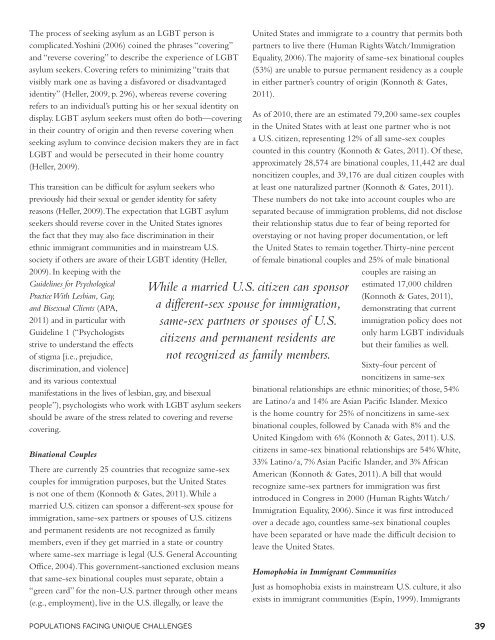Crossroads: The Psychology of Immigration in the New Century
Crossroads: The Psychology of Immigration in the New Century
Crossroads: The Psychology of Immigration in the New Century
Create successful ePaper yourself
Turn your PDF publications into a flip-book with our unique Google optimized e-Paper software.
<strong>The</strong> process <strong>of</strong> seek<strong>in</strong>g asylum as an LGBT person is<br />
complicated. Yosh<strong>in</strong>i (2006) co<strong>in</strong>ed <strong>the</strong> phrases “cover<strong>in</strong>g”<br />
and “reverse cover<strong>in</strong>g” to describe <strong>the</strong> experience <strong>of</strong> LGBT<br />
asylum seekers. Cover<strong>in</strong>g refers to m<strong>in</strong>imiz<strong>in</strong>g “traits that<br />
visibly mark one as hav<strong>in</strong>g a disfavored or disadvantaged<br />
identity” (Heller, 2009, p. 296), whereas reverse cover<strong>in</strong>g<br />
refers to an <strong>in</strong>dividual’s putt<strong>in</strong>g his or her sexual identity on<br />
display. LGBT asylum seekers must <strong>of</strong>ten do both—cover<strong>in</strong>g<br />
<strong>in</strong> <strong>the</strong>ir country <strong>of</strong> orig<strong>in</strong> and <strong>the</strong>n reverse cover<strong>in</strong>g when<br />
seek<strong>in</strong>g asylum to conv<strong>in</strong>ce decision makers <strong>the</strong>y are <strong>in</strong> fact<br />
LGBT and would be persecuted <strong>in</strong> <strong>the</strong>ir home country<br />
(Heller, 2009).<br />
This transition can be difficult for asylum seekers who<br />
previously hid <strong>the</strong>ir sexual or gender identity for safety<br />
reasons (Heller, 2009). <strong>The</strong> expectation that LGBT asylum<br />
seekers should reverse cover <strong>in</strong> <strong>the</strong> United States ignores<br />
<strong>the</strong> fact that <strong>the</strong>y may also face discrim<strong>in</strong>ation <strong>in</strong> <strong>the</strong>ir<br />
ethnic immigrant communities and <strong>in</strong> ma<strong>in</strong>stream U.S.<br />
society if o<strong>the</strong>rs are aware <strong>of</strong> <strong>the</strong>ir LGBT identity (Heller,<br />
2009). In keep<strong>in</strong>g with <strong>the</strong><br />
Guidel<strong>in</strong>es for Psychological<br />
Practice With Lesbian, Gay,<br />
and Bisexual Clients (APA,<br />
2011) and <strong>in</strong> particular with<br />
Guidel<strong>in</strong>e 1 (“Psychologists<br />
strive to understand <strong>the</strong> effects<br />
<strong>of</strong> stigma [i.e., prejudice,<br />
discrim<strong>in</strong>ation, and violence]<br />
and its various contextual<br />
manifestations <strong>in</strong> <strong>the</strong> lives <strong>of</strong> lesbian, gay, and bisexual<br />
people”), psychologists who work with LGBT asylum seekers<br />
should be aware <strong>of</strong> <strong>the</strong> stress related to cover<strong>in</strong>g and reverse<br />
cover<strong>in</strong>g.<br />
B<strong>in</strong>ational Couples<br />
<strong>The</strong>re are currently 25 countries that recognize same-sex<br />
couples for immigration purposes, but <strong>the</strong> United States<br />
is not one <strong>of</strong> <strong>the</strong>m (Konnoth & Gates, 2011). While a<br />
married U.S. citizen can sponsor a different-sex spouse for<br />
immigration, same-sex partners or spouses <strong>of</strong> U.S. citizens<br />
and permanent residents are not recognized as family<br />
members, even if <strong>the</strong>y get married <strong>in</strong> a state or country<br />
where same-sex marriage is legal (U.S. General Account<strong>in</strong>g<br />
Office, 2004). This government-sanctioned exclusion means<br />
that same-sex b<strong>in</strong>ational couples must separate, obta<strong>in</strong> a<br />
“green card” for <strong>the</strong> non-U.S. partner through o<strong>the</strong>r means<br />
(e.g., employment), live <strong>in</strong> <strong>the</strong> U.S. illegally, or leave <strong>the</strong><br />
Populations Fac<strong>in</strong>g Unique Challenges<br />
While a married U.S. citizen can sponsor<br />
a different-sex spouse for immigration,<br />
same-sex partners or spouses <strong>of</strong> U.S.<br />
citizens and permanent residents are<br />
not recognized as family members.<br />
United States and immigrate to a country that permits both<br />
partners to live <strong>the</strong>re (Human Rights Watch/<strong>Immigration</strong><br />
Equality, 2006). <strong>The</strong> majority <strong>of</strong> same-sex b<strong>in</strong>ational couples<br />
(53%) are unable to pursue permanent residency as a couple<br />
<strong>in</strong> ei<strong>the</strong>r partner’s country <strong>of</strong> orig<strong>in</strong> (Konnoth & Gates,<br />
2011).<br />
As <strong>of</strong> 2010, <strong>the</strong>re are an estimated 79,200 same-sex couples<br />
<strong>in</strong> <strong>the</strong> United States with at least one partner who is not<br />
a U.S. citizen, represent<strong>in</strong>g 12% <strong>of</strong> all same-sex couples<br />
counted <strong>in</strong> this country (Konnoth & Gates, 2011). Of <strong>the</strong>se,<br />
approximately 28,574 are b<strong>in</strong>ational couples, 11,442 are dual<br />
noncitizen couples, and 39,176 are dual citizen couples with<br />
at least one naturalized partner (Konnoth & Gates, 2011).<br />
<strong>The</strong>se numbers do not take <strong>in</strong>to account couples who are<br />
separated because <strong>of</strong> immigration problems, did not disclose<br />
<strong>the</strong>ir relationship status due to fear <strong>of</strong> be<strong>in</strong>g reported for<br />
overstay<strong>in</strong>g or not hav<strong>in</strong>g proper documentation, or left<br />
<strong>the</strong> United States to rema<strong>in</strong> toge<strong>the</strong>r. Thirty-n<strong>in</strong>e percent<br />
<strong>of</strong> female b<strong>in</strong>ational couples and 25% <strong>of</strong> male b<strong>in</strong>ational<br />
couples are rais<strong>in</strong>g an<br />
estimated 17,000 children<br />
(Konnoth & Gates, 2011),<br />
demonstrat<strong>in</strong>g that current<br />
immigration policy does not<br />
only harm LGBT <strong>in</strong>dividuals<br />
but <strong>the</strong>ir families as well.<br />
Sixty-four percent <strong>of</strong><br />
noncitizens <strong>in</strong> same-sex<br />
b<strong>in</strong>ational relationships are ethnic m<strong>in</strong>orities; <strong>of</strong> those, 54%<br />
are Lat<strong>in</strong>o/a and 14% are Asian Pacific Islander. Mexico<br />
is <strong>the</strong> home country for 25% <strong>of</strong> noncitizens <strong>in</strong> same-sex<br />
b<strong>in</strong>ational couples, followed by Canada with 8% and <strong>the</strong><br />
United K<strong>in</strong>gdom with 6% (Konnoth & Gates, 2011). U.S.<br />
citizens <strong>in</strong> same-sex b<strong>in</strong>ational relationships are 54% White,<br />
33% Lat<strong>in</strong>o/a, 7% Asian Pacific Islander, and 3% African<br />
American (Konnoth & Gates, 2011). A bill that would<br />
recognize same-sex partners for immigration was first<br />
<strong>in</strong>troduced <strong>in</strong> Congress <strong>in</strong> 2000 (Human Rights Watch/<br />
<strong>Immigration</strong> Equality, 2006). S<strong>in</strong>ce it was first <strong>in</strong>troduced<br />
over a decade ago, countless same-sex b<strong>in</strong>ational couples<br />
have been separated or have made <strong>the</strong> difficult decision to<br />
leave <strong>the</strong> United States.<br />
Homophobia <strong>in</strong> Immigrant Communities<br />
Just as homophobia exists <strong>in</strong> ma<strong>in</strong>stream U.S. culture, it also<br />
exists <strong>in</strong> immigrant communities (Espín, 1999). Immigrants<br />
39
















